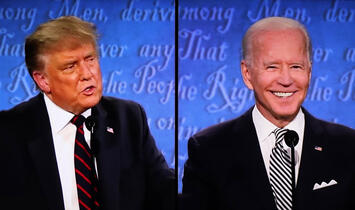
With the presidential race now heating up, the US faces a choice of disastrous proportions. It is shaping up to be an unpopularity contest between Donald Trump – an unstable narcissist – and the doddering, likely corrupt Joe Biden. In fact, three-quarters of Americans think Biden is too old to be re-elected and the majority consider him not mentally up to the job.
Given that the vast majority do not want either of these foolish, dangerous old men to be in power, why not create an alternative party? This was last done successfully in 1854, with the founding of the Republican Party.
The US in 1854 was also deeply divided. At that time, the debate was about slavery, as well as tariffs and growing corporate power. Yet the force of modernity, as Karl Marx recognised at the time, was with the industrialised North, which would go on to crush the agrarian South.
The coalition of the ascendant first came together in 1854 to form the new Republican Party. The Republicans sought to revive the Hamiltonian tradition that had died with the Whigs, who had inherited it from the Federalists. They opposed the Democrats as they became ever more dominated by the interests of plantation owners. In contrast, the Republicans drew support from the industrialists, financiers, mechanics, artisans and independent farmers. Advocates of high protective tariffs and free homesteads for mechanics and farmers, wrote historians Charles and Mary Beard, ‘now mingled with ardent opponents of slavery in the territories’.
At their historic convening in Ripon, Wisconsin, the Republicans adopted a programme that could appeal to a broad spectrum of Americans. They took bold steps to limit slavery’s expansion and also to open new land for small farmers. They supported the growing ranks of American manufacturers and the building of infrastructure to expand the national economy. Abraham Lincoln, before becoming president, had represented railroads in the Midwest.
Today, the preconditions for a new party – and a new mingling of interests – are clearly there. Only 20 per cent of voters rate the economy as ‘excellent’ or ‘good’, versus 49 per cent who call it ‘poor’, notes a New York Times / Siena poll. Americans remain overwhelmingly pessimistic about the country’s future. In one recent poll, almost two in five Americans said they would consider voting for a third-party candidate. If that holds, it would be a larger vote share than either of the current deadly duo can muster.
Conservatives may stick with Trump only because they assume that a Biden re-election would be a disaster. Meanwhile, the Democrats seem to be itching to abandon the awful Biden-Harris ticket. Many Democratic insiders, even in the party’s usually docile media arm, suggest that Biden is too old and too poor a candidate to stand again.
Both parties are basically clueless. Democrats are unable to ditch the left’s stupid identitarian dogma and have foisted the hopelessly ineffective Kamala Harris on the country. Meanwhile, Republican nabobs complain about Trump’s electoral weaknesses, but the party’s core base loves Trump, who in turn alienates middle-of-the-road independent voters and suburban women. Big donors are not likely to pony up to support a party that’s fast in danger of becoming the American equivalent of Marine Le Pen’s National Rally or Germany’s AfD.
Read the rest of this piece at Spiked.
Joel Kotkin is the author of The Coming of Neo-Feudalism: A Warning to the Global Middle Class. He is the Roger Hobbs Presidential Fellow in Urban Futures at Chapman University and Executive Director for Urban Reform Institute. Learn more at joelkotkin.com and follow him on Twitter @joelkotkin.
Photo: Elvert Barnes via Flickr under CC 2.0 License.













No Labels
The ballot-qualifying effort for a third choice goes on in many states, with little coverage by media transfixed by the Biden-Trump dysfunction.